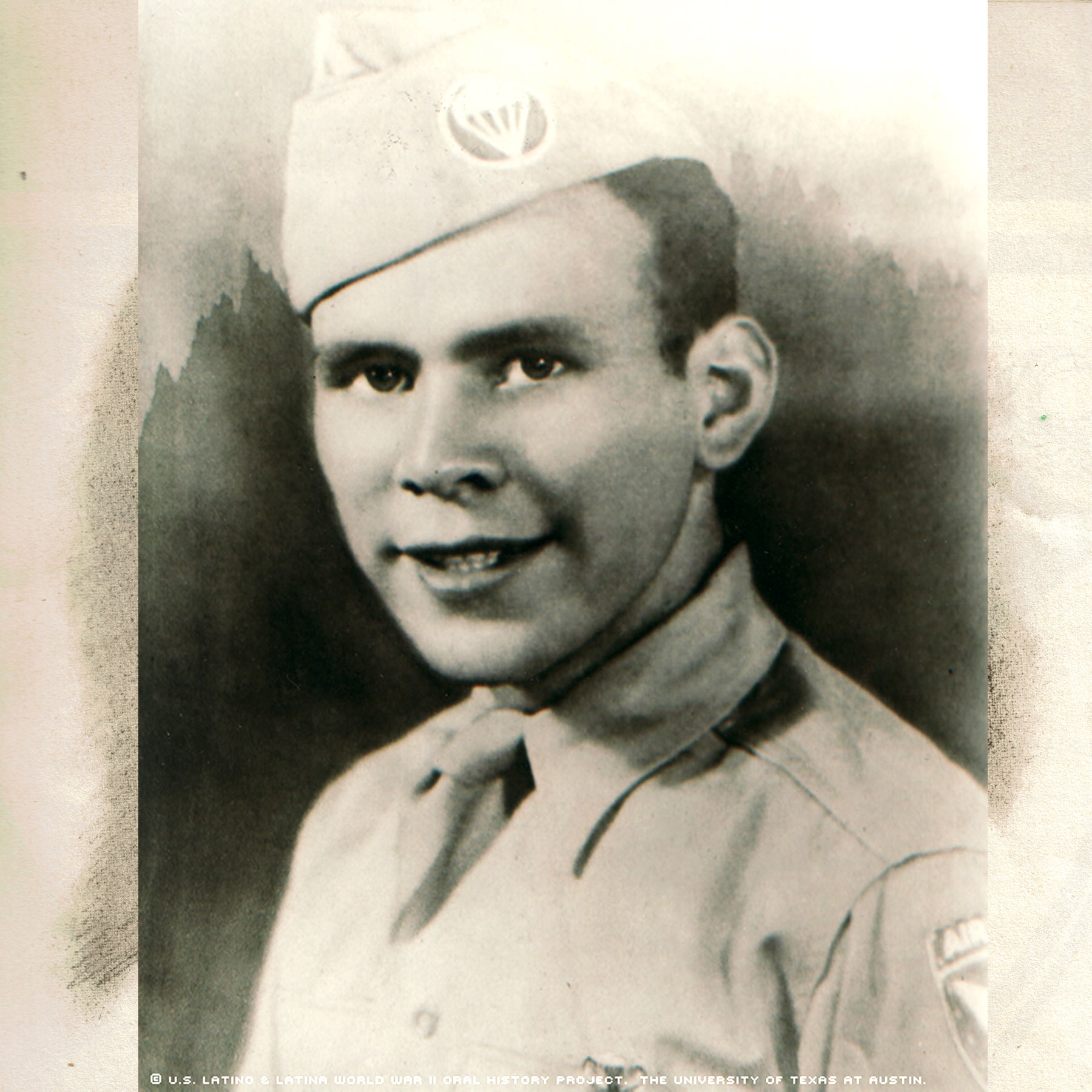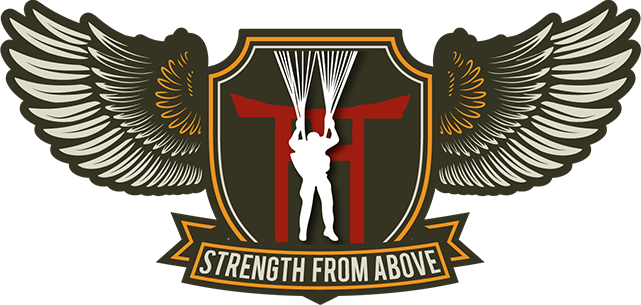Pfc. Pérez, Manuel

A Company, 511 PIR - KIA
03/03/23 - 03/14/45 (Age 22) - gravesite
Citations: Medal of Honor, Combat Infantryman Badge, Purple Heart, Parachutist Badge
Locations: Camp Toccoa, Camp Mackall, Camp Polk, Camp Stoneman, New Guinea, Leyte, Luzon
Manuel "Toots" Pérez was born on March 3, 1923 in the Riverside neighborhood of Oklahoma City, Oklahoma to Manuel (Sr.) and Isidra Pérez. Isidra died when Manuel was only four and a few years later, Manuel and his family moved to Chicago, Illinois (Near West Side at Racine and Taylor Streets), where "Toots" was raised by his father and his paternal grandmother Tiburcia Moncada Pérez at 3511 West Roosevelt Road. His uncle Jesse and aunt Emily Pérez also served as surrogate parents for the future paratrooper and Manuel remained close to his uncle until his (Manuel's) death in 1945.
Manuel attended Chicago's Goodrich and Jackson Elementary Schools and Crane Technical High School on the West Side and the Pérez family attended church together in their Parish of St. Francis of Assisi.
After graduation, Manuel worked at Best Foods, Inc., before the war broke out and Pérez volunteered for parachute duty where he was assigned to Captain Ben Petrie's Company A, 511th Parachute Infantry Regiment, at Camp Toccoa, Georgia in January of 1943. If you would like to learn more about what life was like for Manuel and the 511th PIR at Camp Toccoa, please read our article covering the regiment's time at the post.
Following further training at Camp Mackall, NC; Fort Benning, GA; Camp Polk, LA; Camp Stoneman, CA; and Dobodura, New Guinea; Manuel and the 511th PIR first saw action on the island of Leyte in late 1944. Between November and December, the 511th PIR and their parent unit, the 11th Airborne Division, pushed from the east side of Leyte, over the mountains, to the west coast a campaign that is covered in greater depth in the book WHEN ANGEL'S FALL: FROM TOCCOA TO TOKYO, THE 511TH PARACHUTE INFANTRY REGIMENT IN WORLD WAR II
On February 3, 1945, Manuel and the 511th PIR performed a parachute jump on Tagaytay Ridge, south of Manila on Luzon, then pushed north into the city in a campaign that was costly to both the American liberators and the Japanese defenders (not to mention the local Filipino population).
After watching a lone Japanese soldier commit hari-kari by thrusting his bayonet through his neck, Able Company approached Fort McKinley the next day, February 18 (X+18). As 3rd Platoon’s lead scout, Pfc. Manuel “Toots” Pérez, Jr. was ahead of the main body when the company left the cover of the jungle and started across rice paddies towards Fort McKinley when Toots noticed a heavily fortified cement pillbox.
"His detection of the enemy was very sharp," said A Company's 2LT Theodore "Ted" Baughn. "And his reaction with weapons was very quick and effective."
Unknown to most people, Toots had almost been bounced from the 511th PIR after struggling with his marksmanship back at Camp Mackall. Barely qualifying, the always-smiling Pérez had fought bravely on Leyte as mentioned and now studied the enemy position that threatened 3rd Platoon’s advance on Fort McKinley. Thinking of his comrades’ safety, Manuel rushed into action (it is no wonder that Toots was often described as "a whirlwind paratrooper who never let up regardless of how tough the enemy or how large the odds".)
A Company's 2LT Ted Baughn (Manuel's platoon leader) explained, "I heard someone yell, 'There goes Pérez!' I turned and saw him coming on a dead run. I yelled for him to get down--which had no effect on his concentration."
Medina, New York's SGT Max Polick, Manuel's squad leader, gave a first-hand account of what he saw happen next:
"I was leading the squad on the right flank and Pérez was on my left a little ahead. The Nip (Japanese) pillboxes were thickly covered by heavy sodding and logs. Smaller positions contained one to four riflemen, who covered the larger bunckers that contained the automatic weapons."
Another soldier chimed in, "Hell, those Japs are good with their automatics."
SGT Polick continued:
"The Japs were throwing direct fire with their 20 millimeter machine guns and there wasn't a helluva lot of cover. Immediately behind the main line of fortifications was a big concrete bunker which housed twin 50 caliber machine guns. Pérez ran out, ducking this way and that, carrying an armful of grenades.
"We covered him with fire as he ran from one pillbox to the next tossing grenades into the ports and knocking out the guns. The only time he withdrew was for more grenades. After he had dusted off the pillboxes, the riflemen moved in and mopped up."
Manuel then crawled right up to the largest bunker, the twelfth he assaulted that day, in the middle of heavy automatic weapons fire, something SGT Polick said was "the damnest thing" he had ever seen as nearby snipers were firing on Pérez.
"Then he ran around to the front of the bunker and tossed in a couple of grenades. There was a helluva blast. Then Pérez climbed to the top and dropped in two white phospherous grenades through a vent.
"I saw him flattened out and then the grenades exploded. There was lots of white smoke. Pérez sat right in the middle of it, looking over at us and grinning. He held up his hand and made a circle with his thumb and forefinger. The slugs were cutting the breeze all around, but he didn't seem to care.
"Pérez got the smaller pillbox next-door by raising up his rifle and firing four times into it. Then he jumped down the rear. Japs were pouring out and he shot and killed eight of them with his rifle.
"One Nip crawled out and charged Pérez from the rear. I shouted, "Look out!" Pérez turned just as the Jap hurled his bayonet like a spear. Pérez used his rifle to knock down the flying bayonet. The shock knocked his gun spinning. Pérez grabbed up the Nip's rifle and bayoneted the howling Jap with it.
"Four more Japs then started out of the pillbox tunnel. Pérez clubbed two to death, and bayoneted the other two. Then he entered the pillbox and found one live Jap. He bayoneted him."
The Medal of Honor citation (full text at bottom) for the usually quiet, but very well-liked paratrooper “who couldn’t shoot straight” noted that Pérez, "Single-handedly... killed 18 of the enemy in neutralizing the position that had held up the advance of his entire company....”
There are discrepancies to the amount of enemy dead, however. While sources often say "18", if you count up the number of Japanese mentioned in his official Medal of Honor citation, the number is 23. However, even that number is most likely too low.
SGT Max Polick (Manuel's squad leader) later said, "Among the grenades, rifle and bayonet, the count of dead Japs was more like 75."
One piece of the story that is often overlooked is that 2LT Ted Baughn went up with Pérez during the attacks on the pillboxes. Baughn testified that Manuel "Probably saved my life, warning me when a Jap grenade was coming in my direction and went off near my head."
Manuel's best friend PFC Ancel J. Upton, another lead scout, added incredible insight into the heroic trooper that day, saying, "He told me on the morning that we pulled out that he was very tired and weary of this war and that today he was going to get killed or wounded - that he was going back to the States, one way or another. Well, he almost did that day as a Jap was running toward him from behind with his bayonet raised, but when he got about seven or eight feet of Pérez someone blew the JAP's head off."
Toot's actions at Fort McKinley spread throughout the 511th PIR and efforts to award him the Medal of Honor began fairly quickly, something that Pérez was aware of. On February 28, 1945, just ten days after his one-man assault on the enemy's fortifications, Manuel wrote to his uncle, Private Jesse Pérez, who was also in the South Pacific: “Dear Uncle … they are putting me in for a medal and it’s not the purple heart, you will be surprised how big it’s going to be … Your Nephew, Manuel Pérez, Jr.”
Sadly, PFC Pérez was killed one month later on March 14, 1945, outside Santo Thomas assaulting another bunker, alone. He had just celebrated his twenty-second birthday eleven days earlier.
An unknown buddy from A Company watched Manuel fall. He said, "(Pérez) was the first G.I. into Santo Thomas. We'd run into heavy machine gun fire from Japanese positions in the ditches. Then they started throwing mortars at us."
His pinned down squadmates watched "Toots" grab an armful of grenades and start throwing them from behind a log. When Manuel ran out of grenades, he stood and began firing his rifle as he moved back for more. Suddenly, and to the shock of his fellow paratroopers, a sniper's bullet caught Manuel through the chest. He died shortly thereafter.
A Company immediately wanted to rush out to recover Manuel's body, but the C.O. wisely ordered them to sit tight, saying, "We know he's dead and I'm not going to get any of the rest of you killed just to get him."
As one newspaper later reported, everyone in the 511th Parachute Infantry Regiment "said it was hard to believe that one bullet could kill such a tough little man."
Pérez was buried with full military honors at Fairlawn Cemetery which is located in Oklahoma City, Oklahoma. Then on February 22, 1946, Manuel's Medal of Honor was presented to his father (who had moved to Nuevo Laredo, Mexico) on the International Bridge between Laredo, Texas, and Nuevo Laredo, Tamaulipas, Mexico.
Later that same year, shortly after the war ended, returning Mexican American veterans formed Chicago’s American Legion Manuel Pérez, Jr. Post 1017 in honor of Pérez’s memory. Three years later, Pérez’s body was returned to Chicago for formal memorial services, which were conducted by the post. From Chicago, the body was escorted to Oklahoma City for final burial.
In his honor, the Manuel Perez, Junior Army Reserve Center was dedicated at 3021 West Reno in 1961. In 1979 the people of Oklahoma City's Riverside community and the American GI Forum raised funds to provide a small park and monument honoring Manuel at SW 14 and Harvey. During the dedication, Reverand Peter Scagnelli of Little Flower Catholic Church said, "Manuel was born here, and he typifies the spirit of the Riverside neighborhood."
The Manuel Pérez, Jr. Plaza in Chicago’s Little Village was dedicated April 25, 1981, by Mayor Jane Bryne, and a new elementary school named after Pérez was dedicated in Chicago’s Pilsen Community on May 30, 1990.
Then on November 11, 2020, Veterans Day, the new Oklahoma Medal of Honor Memorial at Manuel Perez Park was unveiled in a ceremony by Mayor David Holt and other civic leaders."
Manuel Pérez's full citation for the Medal of Honor:
GENERAL ORDERS:
War Department, General Orders No. 124 (December 27, 1945)
The President of the United States of America, in the name of Congress, takes pride in presenting the Medal of Honor (Posthumously) to Private First Class Manuel Perez, Jr., United States Army, for conspicuous gallantry and intrepidity in action above and beyond the call of duty on 13 February 1945, while serving with Company A, 511th Parachute Infantry Regiment, 11th Airborne Division.
Private First Class Perez was lead scout for Company A, which had destroyed 11 of 12 pillboxes in a strongly fortified sector defending the approach to enemy-held Fort William McKinley on Luzon, Philippine Islands. In the reduction of these pillboxes, he killed five Japanese in the open and blasted others in pillboxes with grenades. Realizing the urgent need for taking the last emplacement, which contained two twin-mount .50-caliber dual-purpose machineguns, he took a circuitous route to within 20 yards of the position, killing four of the enemy in his advance. He threw a grenade into the pillbox, and, as the crew started withdrawing through a tunnel just to the rear of the emplacement, shot and killed four before exhausting his clip. He had reloaded and killed four more when an escaping Japanese threw his rifle with fixed bayonet at him. In warding off this thrust, his own rifle was knocked to the ground. Seizing the Jap rifle, he continued firing, killing two more of the enemy. He rushed the remaining Japanese, killed three of them with the butt of the rifle and entered the pillbox, where he bayoneted the one surviving hostile soldier. Single-handedly, he killed 18 of the enemy in neutralizing the position that had held up the advance of his entire company.
Through his courageous determination and heroic disregard of grave danger, Private First Class Perez made possible the successful advance of his unit toward a valuable objective and provided a lasting inspiration for his comrades.
To learn more about the 11th Airborne Division in World War II, please consider purchasing a copy of our books on the Angels:

